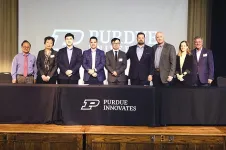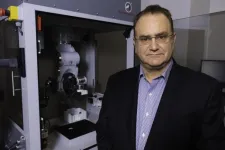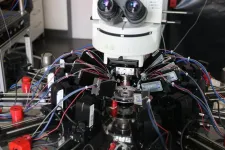(Press-News.org) A heart attack will leave a permanent scar on a human heart, yet other animals, including some fish and amphibians, can clear cardiac scar tissue and regrow damaged muscle as adults.
Scientists have sought to figure out how special power works in hopes of advancing medical treatments for human cardiac patients, but the great physiological differences between fish and mammals make such inquiries difficult.
So University of Utah biologists, led by assistant professor Jamie Gagnon, tackled the problem by comparing two fish species: zebrafish, which can regenerate its heart, and medaka, which cannot.
A tale of two fish
The team identified a few possible explanations, mostly associated with the immune system, for how zebrafish fix cardiac tissue, according to newly published research.
“We thought by comparing these two fish that have similar heart morphology and live in similar habitats, we could have a better chance of actually finding what the main differences are,” said Clayton Carey, a postdoctoral researcher in the Gagnon lab and lead author on the new study.
Gagnon’s team wasn’t able to solve the mystery—yet—but their study shed new light on the molecular and cellular mechanisms at play in zebrafish’s heart regeneration.
“It told us these two hearts that look very similar are actually very different,” Gagnon said.
Both members of the teleost family of ray-finned fish, zebrafish (Danio rerio) and medaka (Oryzias latipes) descended from a common ancestor that lived millions of years ago. Both are about 1.5 inches long, inhabit freshwater and are equipped with two-chamber hearts. Medaka are native to Japan and zebrafish are native to the Ganges River basin.
According to the study, the existence of non-regenerating fish presents an opportunity to contrast the differing responses to injury to identify the cellular features unique to regenerating species. Gagnon suspects heart regeneration is an ancestral trait common to all teleosts.
Understanding the evolutionary path that led to the loss of this ability in some teleost species could offer parallel insights into why mammals cannot regenerate as adults.
With their distinctive horizontal stripes, zebrafish have long been popular as pets in the United States. In the 1970s zebrafish were embraced by biologists as a model organism for studying embryonic development of vertebrates.
Scientists like zebrafish because they can be propagated by the thousands quickly in labs, are easy to study and proved to be extremely hardy.
Cold shock to the heart
To conduct their experiments, the Gagnon lab used a device called a cryoprobe to injure the fish hearts in ways that mimic heart attacks in humans, then extracted the hearts after certain time frames to learn how the two species responded differently.
Carey made the cryoprobe from a piece of copper wire, which was cooled in liquid nitrogen to about minus 170 degrees Celsius. Team members cut tiny incisions in the fish’s bellies to expose their hearts, then applied the probe for 23 seconds to the edge of the heart.
In 95% of the cases, the fish survived the procedure, although not for long. After three days or 14 days, their hearts were extracted and dissolved into a single-cell solution, which was then subjected to RNA sequencing in search of markers indicating how the fish responded to the injury.
“Zebrafish have this immune response that is typical of what you might see during a viral infection, called an interferon response,” Carey said. “That response is completely absent in medaka.”
The study documented differences in immune cell recruitment and behavior, epicardial and endothelial cell signaling, and alterations in the structure and makeup of the heart. For example, medaka lack a certain type of muscle cells that are present in zebrafish.
How zebrafish heal damaged cardiac tissue
“My hunch is the ancestor of all animals could regenerate its heart after an injury, and then that’s been repeatedly lost in different types of animals,” Gagnon said. “I would like to understand why. Why would you lose this great feature that allows you to regenerate your heart after an injury?”
The study indicates the zebrafish’s ability to regenerate has something to do with its immune system, but understanding exactly how would take more research. For example, far more macrophages, specialized immune cells, migrated into the wound site in zebrafish than in medaka.
Unlike medaka, the zebrafish form a transient scar that doesn’t calcify into rigid tissue.
“What you do with that scar is what matters,” Gagnon said. “We think that the interferon response causes these specialized macrophage cells to come into that wound site and start to promote the growth of new blood vessels.”
Over time new muscle replaces the damaged cardiac tissue and the heart heals.
“The more we learn about how animals can regenerate tissues, how those features have been lost in us and other animals, that’s going to help us think about our limitations and how we might engineer strategies to help us overcome those,” Gagnon said. “Our hope is that we build this knowledge base in animals that are really accessible and can be studied in incredible detail, then use that knowledge to generate more focused experiments in mammals, and then maybe someday in human patients.”
######
The study titled, “Distinct features of the regenerating heart uncovered through comparative single-cell profiling,” appears in the April 2024 edition of the journal Biology Open and was funded by the National Institutes of Health. Gagnon Lab members Hailey Hollins and Alexis Schmid are listed co-authors.
END
Why can zebrafish regenerate damaged heart tissue, while other fish species cannot?
University of Utah biologists discover that tiny tropical fish's "superpower" lies in an immune response to heart injuries
2024-04-19
ELSE PRESS RELEASES FROM THIS DATE:
Keck School of Medicine of USC orthopaedic surgery chair elected as 2024 AAAS fellow
2024-04-19
The American Association for the Advancement of Science (AAAS) has elected surgeon-researcher Jay Lieberman, MD, chair and professor of orthopaedic surgery at the Keck School of Medicine of USC, among its class of 2024 fellows.
The AAAS is the world’s oldest and largest general science organization and the publisher of Science, a top peer-reviewed academic journal. Election as a fellow is a lifetime honor — and one of the AAAS’s highest — signaling extraordinary achievement in the advancement or application of science.
Lieberman ...
Returning rare earth element production to the United States
2024-04-18
WEST LAFAYETTE, Ind. — ReElement Technologies on Thursday (April 18) signed an exclusive license to use patented Purdue University technologies to domestically refine and sell minerals critical in manufacturing modern, high-tech products for commercial and industrial use.
The license was signed during the Purdue Innovates Startup and Technology Expo 2024 at the Purdue University Memorial Union.
Sourcing rare earth and critical battery elements
Rare earth elements are foundational essentials in permanent ...
University of Houston Professor Kaushik Rajashekara elected International Fellow of the Engineering Academy of Japan
2024-04-18
Kaushik Rajashekara, Distinguished Professor of Engineering at the University of Houston Cullen College of Engineering, continues to receive recognition and awards on a global scale. The man who ushered in the era of electric cars, working on the General Motors EV1 in 1995 when he was a Technical Fellow there, has been elected an International Fellow of the Engineering Academy of Japan, recognized for his contributions to power conversion and, of course, electrification of transportation.
According to the academy, Rajashekara’s ...
Solving antibiotic and pesticide resistance with infectious worms
2024-04-18
To study how parasites evolve to break the defenses of their hosts, the National Institutes of Health has granted UC Riverside nematologist Simon “Niels” Groen a $1.9 million Outstanding Investigator Award.
Roundworm parasites infect humans, livestock, and crop plants. Insights into why certain worms can evade host immune protections could help preempt a ticking time bomb: the decreasing effectiveness of pesticides and antibiotics for infections.
Bacterial, fungal, and parasite resistance to drugs and pesticides is making it harder, and sometimes impossible, to treat common infections ...
Three ORNL scientists elected AAAS Fellows
2024-04-18
Three scientists from the Department of Energy’s Oak Ridge National Laboratory have been elected fellows of the American Association for the Advancement of Science, or AAAS, the world’s largest general scientific society and publisher of the Science family of journals.
"Keith Kline, Rigoberto Advincula and Takeshi Egami have delivered significant impact for the scientific community," said ORNL Director Stephen Streiffer. "This distinguished honor highlights their commitment, hard work and leadership in their respective fields. I offer my congratulations to them on this well-deserved recognition.”
AAAS ...
Rice bioengineers win $1.4 million ARPA-H grant for osteoarthritis research
2024-04-18
HOUSTON – (April 18, 2024) – Bioengineers at Rice University have been awarded $1.4 million as part of a multi-center consortium funded by the Advanced Research Projects Agency for Health (ARPA-H) to develop strategies for reversing the effects of osteoarthritis.
“We’re thrilled to be a part of this collaborative effort to tackle one of the most challenging degenerative joint diseases and develop, test and commercialize solutions for patients,” said Antonios Mikos, the Louis Calder Professor of Chemical Engineering and professor of bioengineering ...
COVID-19 booster immunity lasts much longer than primary series alone, York University-led study shows
2024-04-18
April 18, 2024, TORONTO – Thinking about getting a spring-time booster shot? A new study coming out of York University’s Centre for Disease Modelling in the Faculty of Science shows that immunity after a COVID-19 booster lasts much longer than the primary series alone. These findings are among other, sometimes “unintuitive,” revelations of how factors like age, sex and comorbidities do and don’t affect immune response.
The study’s authors – York Post Doctoral researchers Chapin ...
Bentham Science joins United2Act
2024-04-18
Bentham Science Publishers is now a signatory organization of United2Act's consensus statement on paper mills.
We are committed to upholding the highest standards of research integrity in academic and scientific publishing. Part of the effort to uphold integrity in scientific publishing includes preventing publication from fraudulent 'paper mills' which negatively impact the credibility of research. We fully support the COPE position statement on this critical issue.
The intrusion of fraudulent papers into the publication record not only undermines public trust in research but also poses significant risks to ...
When thoughts flow in one direction
2024-04-18
Contrary to previous assumptions, nerve cells in the human neocortex are wired differently than in mice. Those are the findings of a new study conducted by Charité – Universitätsmedizin Berlin and published in the journal Science.* The study found that human neurons communicate in one direction, while in mice, signals tend to flow in loops. This increases the efficiency and capacity of the human brain to process information. These discoveries could further the development of artificial neural networks.
The neocortex, a critical structure for human intelligence, is less than five millimeters thick. There, in the outermost layer of the brain, 20 billion neurons process ...
Scientists identify airway cells that sense aspirated water and acid reflux
2024-04-18
Scientists Identify Airway Cells That Sense Aspirated Water and Acid Reflux
The new work by UCSF researchers could lead to interventions to prevent pneumonia or treat certain types of chronic cough.
When a mouthful of water goes down the wrong pipe – heading toward a healthy person’s lungs instead of their gut – they start coughing uncontrollably. That’s because their upper airway senses the water and quickly signals the brain. The same coughing reflex is set off in people with acid reflux, when acid from the stomach reaches the throat.
Now, UC San Francisco scientists have identified the rare type of cell responsible ...
LAST 30 PRESS RELEASES:
URI researchers uncover molecular mechanisms behind speciation in corals
Chitin based carbon aerogel offers a cleaner way to store thermal energy
Tracing hidden sources of nitrate pollution in rapidly changing rural urban landscapes
Viruses on plastic pollution may quietly accelerate the spread of antibiotic resistance
Three UH Rainbow Babies & Children’s faculty elected to prestigious American Pediatric Society
Tunnel resilience models unveiled to aid post-earthquake recovery
Satellite communication systems: the future of 5G/6G connectivity
Space computing power networks: a new frontier for satellite technologies
Experiments advance potential of protein that makes hydrogen sulfide as a therapeutic target for Alzheimer’s disease
Examining private equity’s role in fertility care
Current Molecular Pharmacology achieves a landmark: real-time CiteScore advances to 7.2
Skeletal muscle epigenetic clocks developed using postmortem tissue from an Asian population
Estimating unemployment rates with social media data
Climate policies can backfire by eroding “green” values, study finds
Too much screen time too soon? A*STAR study links infant screen exposure to brain changes and teen anxiety
Global psychiatry mourns Professor Dan Stein, visionary who transformed mental health science across Africa and beyond
KIST develops eco-friendly palladium recovery technology to safeguard resource security
Statins significantly reduce mortality risk for adults with diabetes, regardless of cardiovascular risk
Brain immune cells may drive more damage in females than males with Alzheimer’s
Evidence-based recommendations empower clinicians to manage epilepsy in pregnancy
Fungus turns bark beetles’ defenses against them
There are new antivirals being tested for herpesviruses. Scientists now know how they work
CDI scientist, colleagues author review of global burden of fungus Candida auris
How does stroke influence speech comprehension?
B cells transiently unlock their plasticity, risking lymphoma development
Advanced AI dodel predicts spoken language outcomes in deaf children after cochlear implants
Multimodal imaging-based cerebral blood flow prediction model development in simulated microgravity
Accelerated streaming subgraph matching framework is faster, more robust, and scalable
Gestational diabetes rose every year in the US since 2016
OHSU researchers find breast cancer drug boosts leukemia treatment
[Press-News.org] Why can zebrafish regenerate damaged heart tissue, while other fish species cannot?University of Utah biologists discover that tiny tropical fish's "superpower" lies in an immune response to heart injuries








